By 2050, we’re expected to have to feed 10 billion people.
The problem is, that’s much easier said than done. The current way we approach agriculture and food production in the western world is super inefficient and not sustainable for the long term.
If we attempt to feed that many people with our current methods, it would not be a pretty situation. We’d run out of resources and destroy our environment in the process.
To preface, we currently produce enough food to theoretically feed ten billion individuals. The problem is, we waste so much of it that this isn’t what realistically happens.
For instance, in the United States, although 1 in 8 households suffer from food insecurity, while 40% of the national food supply goes to waste.
However, the likelihood that we’ll be able to stop wasting food completely is little to none, and either way, our food production systems we currently use are begging for improvement:
- It takes 2400 gallons of water are required to produce just one pound of meat. That’s the equivalent of drinking 38 400 cups of water 🤯.
- Livestock production accounts for 70% of all agricultural land use, occupying 30% of the Earth’s land surface.
- 18% of the greenhouse gases on Earth are being produced as a result of the cultivation of lifestock and crop. Agriculture is the largest producer of non CO2 based greenhouse gases.
- Globally, we waste the meat of 12 billion animals every year, with more that half of that meat being usable.
- An estimated 75% of global land clearing and degradation is driven by agriculture.
- If all grain were fed to humans instead of animals, we could feed an extra 3.5 billion people.
… The stats go on and on, raising a TON of questions regarding it’s sustainability, ethicality, and overall efficiency. To put it bluntly, our approach to agriculture right now sucks.
The implications are clear. In order to feed 10 billion people in a nutritional way and not destroy our environment in the process, we need to make a change. So, what technologies and techniques can we employ in order to make this a reality?
From 🌱 to 🌲: How Are We Actually Going to Produce Our Food?
The process of growing food can get pretty complex, especially when you’re considering something like obtaining protein.
That being said, there are currently a lot of interesting ideas being laid out concerning how we can change our approach to food, all with their own respective pros and cons. However, in general, these solutions offer the promise of a cleaner and more nutritious future.
It’s also important to note that meat production uses the most energy and resources in conventional farming. As a result of this and our growing population, our two diet options are to either shift over to a plant/fungi-based diet or completely reinvent the way we approach protein.
However, the following ideas can be combined to find a balance of both choices 😉.
🌾 Vertical Farming
* I’ve written about vertical farming before. If you want to get a deeper look into what exactly this entails, click here 🙂
In a nutshell:
Vertical farming is the practice of growing crops in vertically stacked layers. It takes in controlled environment agriculture, and soilless farming techniques like hydroponics, aeroponics, and aquaponics to produce nutritious yields of food.
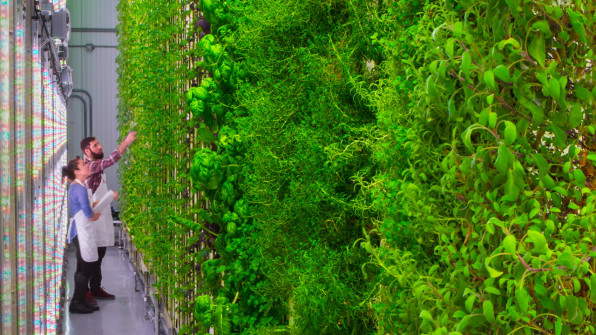
Plenty’s vertical farm in San Francisco
Traditional farms grow crops in horizontal lines that expand over large amounts of lands, while vertical farms achieve the same yield with significantly less space taken up.
Through this, we’re able to get more food per square foot of land. In addition:
- Vertical farming allows us to produce more crops from the same square footage of growing area. In fact, 1 acre of an indoor area offers equivalent production to at least 4–6 acres of outdoor capacity, and this can still get monumentally higher. A facility in Japan is able to grow 100x more crops than the traditional farm.
- We have a limited amount of freshwater on Earth, and conventional farming uses 70% of it. Vertical farming allows us to produce crops with 70–95 percent less water than traditional systems.
- Crops in fields are vulnerable to storms, bugs, and other disasters, all things which are increasing as a result of climate change. Vertical Farms are protected from all of these things.
- Since there are no bugs, vertical farming doesn’t require pesticides either. Special lighting provides the growth of nutritious, organic, pesticide-free crops.
That being said, it isn’t perfect. Vertical farming takes up monumental amounts of energy (since we’re growing crops indoors), has very high startup costs (taking around 6–7 years to pay pack the initial investment), and is not suitable for all crops to grow in.
However, if further development is put into this, it is possible that we will be able to overcome these hurdles, or at least make vertical farming more accessible.
🌱 Plant-Based Meats
If you took a look at the statistics at the beginning of this article, you might have noticed that meat from animals contributed largely to the impact that agriculture had on the environment.
The problem is, meat has become super integrated into our lives, and there’s no way that everyone would be able to just quit cold-turkey (haha pun intended) without any complaints.
Rather than forcing individuals to completely shift away from meat, we can produce burgers and other typical meat products from plant sources, like chickpeas.
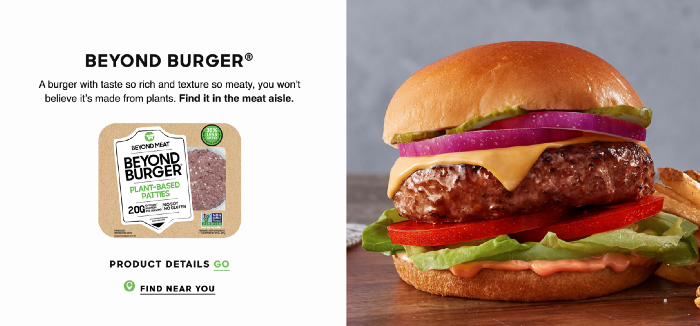
Beyond Meat is a company that creates ‘meat’ products from plant sources. Their burger is made of a variety of ingredients, however, most of the protein comes from the legumes integrated into their recipe.
However, plant-based meat doesn’t exactly feel like the meat we’ve grown used to consuming. Animals contain muscle cells, which are naturally springy and flexible in order to help them move around. This is why meat often comes off as chewy.
However, plants never needed to really move around, and so, their cells are rather rigid and lack flexibility. This is the reason why sometimes when plant based meat is consumed, it’ll come off as a bit mushy or crumbly.
That being said, plant based meat is more environmentally sustainable and can improve the health of those consuming it over traditional meat.
A study conducted by Stanford University using Beyond Meat’s alternative protein products found, that after 8 weeks, participants who consumed plant-based protein:
- Had lower levels of LDL cholesterol (a.k.a. ‘bad cholesterol), which dropped on average 10 milligrams per deciliter.
- Had lower levels of TMAO, reducing their risk for adverse cardiovascular events, like heart attacks.
- Dropped 2 pounds (on average) during the plant-based portion of the diet while caloric intake was held steady.
In regards to the environment, when compared to ¼ pound of traditional U.S. beef, plant-based proteins emit 90% less greenhouse gas emissions, require 45% less energy, have a 99% less impact on water scarcity, and use 93% less land.
🍄 Mycology
Have you ever walked into a forest, noticed some mushrooms, and contemplated whether or not you could eat them?
With mycology, we’re studying fungi, but, we’re also looking at how mushrooms impact us as humans.
Well, although some mushrooms are definitely poisonous and not meant for human consumption, mushrooms and fungi are jam-packed with nutrients and basically have everything we need to survive:
- High protein content: 20–30% of mushrooms is crude protein as a percentage of dry matter. High protein content makes them an ideal food because they contain all the amino acids essential to human nutrition;
- Carbohydrates: After moisture, which accounts for 90% of fresh weight, carbohydrates are the main component of mushrooms, providing as a good source of glucose + energy;
- Low Energy Value: Mushrooms contain an average of 85–125 kJ per 100 g whereas an adult male needs about 10 000 kJ per day. This low energy value of mushrooms enables it to be used in low-calorie diets, ideal for diabetics;
- Fats: Mushrooms are characteristically low in fat, comprising 2–8% dry weight. This crude fat includes representatives of all classes of lipid compounds including free fatty acids, glycerides, sterols, and phospholipids. Of existing fatty acids, a high proportion are linoleic acid (the only essential fatty acid required in the human diet), has been found to be 63–74% of total fatty acids;
- Cholesterol: Mushrooms are cholesetrol-free sources of nutrition;
- Vitamin B: The fruit body of a mushroom is an excellent source of B-complex vitamins including riboflavin (B2) niacin, pantothenic acid, thiamin (B1) biotin, folate and vitamin B12. Mushrooms are a particularly rich source of riboflavin as well;
- Vitamin B12: Mushrooms are unique in that they contain Vitamin B12, something that vegetables can’t produce at all. Since B12 is mainly of animal origin, deficiency is commonly associated with vegetarian diets. Mushrooms were found to contain 0.32–0.65 mg per gram of B12, allowing just 3 g of fresh mushrooms to provide the recommended daily allowance of this vitamin;
- Other: Approximately 104 mg of phosphorus can be supplied by 5 raw button mushrooms; 100 g of mushrooms would also supply more than half the daily requirement of copper. Mushrooms are also an excellent source of selenium. Foods of animal origin and cereal grains are sources of selenium, but among fresh produce, only mushrooms are a good source.
Fungi is found in varying levels of acidity and is pretty easy to grow. It’s significantly faster than growing crops and has a smaller impact than growing meat.
However, fungi-based diets are generally low calorie. This means that we likely would need to consume some additional source of nutrition in order to help meet our daily caloric intake needs.
Note: Fungi is also entering the meat start-up space. In 2020, start-up Emery Foods announced that they would be producing fungi-based steaks, and are currently the leading start-up working on optimizing off of fungi and meat.
🐄 Cultured Proteins: Growing Protein without the Animal
What if, rather than growing animals from birth and slaughtering them, we were able to grow proteins from stem cells?
Although it sounds super futuristic, this is an actual possibility, and something that’s already been done!
Cultured protein is protein produced by the in vitro cell culture of animal (typically 🐮 bovine, 🐷 porcine, or 🐦avian) cells.
Animals are raised from birth and their stem cells are extracted. In mammalian cell culture, embryonic stem cells are typically used, meaning the meat we grow comes from the embryos of pregnant animals.
In order for the cell to grow and proliferate, a growth medium is given to the stem cell. These contain a variety of amino acids, inorganic salts, sugars, and growth factors that help the cell thrive. However, in order for the medium to be effective, it usually has to be supplemented with something additional.
Generally, for mammalian cell culture, we use serum made from animal blood or recombinant growth factors, however, this is expensive and brings up questions concerning the ethics of cultured meat.
But, there’s a solution to this. Rather than using bovine, avian, or porcine stem cells in order to grow meat, we could actually use insect stem cells to grow proteins!
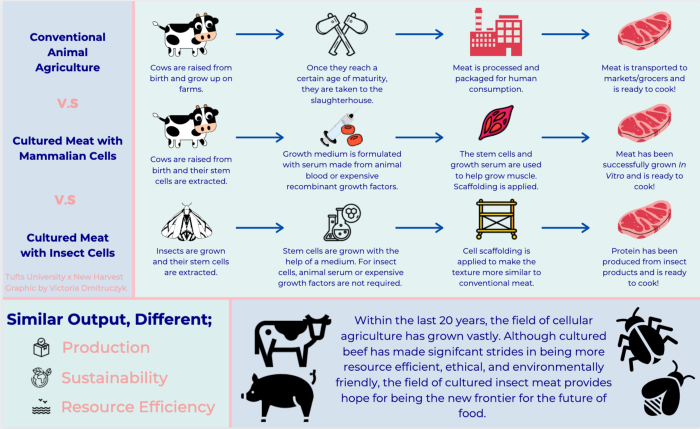
Comparing conventional agriculture to cultivated meat with mammalian and insect cells.
The processes for growing protein from insect stem cells are generally similar to growing protein from conventional sources, however, there is a difference.
The media used to help grow protein from insect cells does not necessarily require an animal serum or recombinant growth factors, meaning the cost is driven down, while the ethicality of the process goes up.
Insects, when compared to traditional meat, are much more nutritious. Although all bugs vary in nutritional quality, for 100 g of crickets (crickets in general, not cultivated protein):
- You’ll get 60 g of protein. In comparison, an identical serving of chicken will give you 31 g, and dried beef will give you 41 grams.
- You’ll get your dosage of all nine essential amino acids, which are needed for things like the building of proteins and synthesis of hormones and neurotransmitters. This makes crickets the perfect source of alternative protein.
- You’ll obtain a large amount of the omega acids, including the Omega-3s and Omega-6s.
- You’ll receive extremely high levels of vitamin B12. Depending on how it’s produced, 100g of crickets can give you up to 1,587.6% of your daily minimum intake.
- You’ll receive a significant amount of vitamins, minerals, and other key nutrients.
- 80% of a cricket is digestible. The next best competitor, the chicken, is only 50% digestible and offers way less nutritional value.
However, even though they have a multitude of benefits, most people in the western world shudder when they hear the term ‘insect meat’.
Since eating lab grown protein from insect cells is not the same as eating insects in the traditional way they’re cooked, this may help us get over some hurdles concerning consumer bias.
However, once we get past the steps of growing the protein, with most insect and animal-cell based protein scaffolding is required.
This helps the final product mimic the texture of conventional meat in addition to supporting changes in the product’s size (ex. helping a meat patty be the size of a pound of steak rather than something smaller).
Although the texture is not 100% accurate right now, with enough effort put towards the cellular agriculture effort, it is likely that this could be very feasible.
In regards to taste, insect and animal-based proteins are designed to mimic the taste of their respective sources. But what about the cost?
Right now, it’s pretty expensive to grow cultured meat. The media themselves are expensive, and the R&D costs help add to the price of actually growing protein itself.
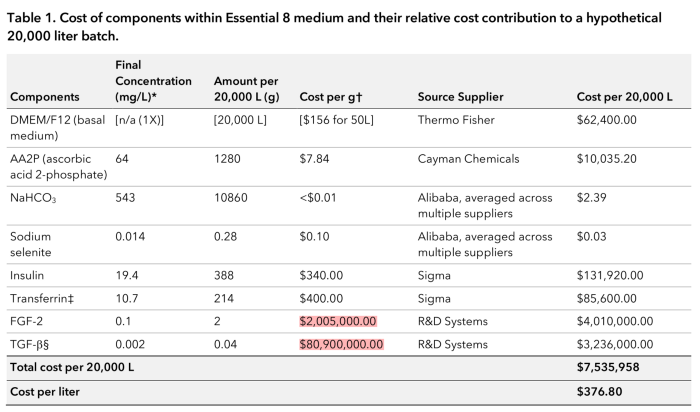
This paper by the Good Food Institute in 2017 analyzed how we could potentially cut down the cost of Essential 8 TM, a popular media. Note how the two recombinant growth factors are immensely expensive and lead to the price being almost $400/L
That being said, there are various approaches we could take to take the cost of media down to an amount that is equivalent to that of the production of conventional meat.
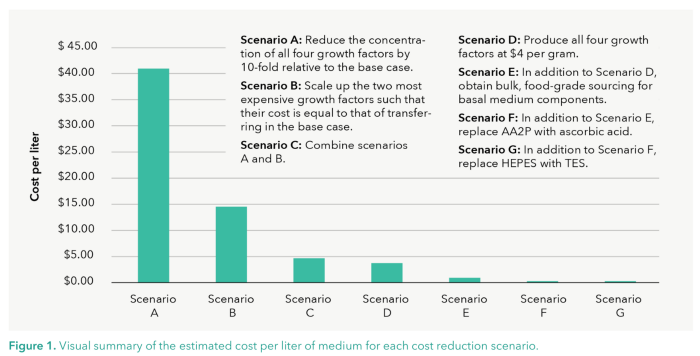
The same paper was able to cut down the cost of media to ~$0.24 USD/L
The media used for the production of insect-cell based proteins is also significantly cheaper than that of the animal-cell alternative. Since recombinant proteins are not used, the media itself is cheaper. However, this does not mean that insect-based protein is cheaper as of yet.
The cell density of insect cells is smaller than that of animal cells, and so, when we grow proteins, there generally ends up being less than that of what would have been produced with animal cells.
There’s still a lot of progress that needs to be regarding how we could further cut down the cost for the media and process in both insect-cell based and mammalian-cell culture, however, it does have the potential to one day match that of conventional meat production.
Cultured meat also comes with its environmental benefits. It takes up 99% less land, uses 96% less freshwater and emits 80% less greenhouse gases than traditional meat production.
However, some researchers believe that the high levels of energy required for producing lab grown foods will actually have worse of an impact on the environment and our warming climate. Unfortunately, not enough is known about the impact of lab-grown foods to give a fully concrete opinion leaning towards one side.
There are a lot of ways we could consider reinventing agriculture in order to feed such a large population.
But, it all starts with us.
Without creating a significant change to the way we approach food, we’ll lead ourselves into a disaster we can’t escape.
Being conscious of how we’re approaching our food right now and how we can change this is step one. But actually choosing to research, purchase, or invest into these alternative diets is a key step we all need to take in order to ensure food security in the future.
🔑 Key Takeaways
- In order to feed 10 billion people, we would need either switch over to plant-based diets, or find alternative sources of protein. By combining the two we can manage to continue to ingest the food we eat today.
- Vertical farming is able to grow more crop per square foot of land, and use significantly less water, land, and feed, however, is more expensive and requires more energy.
- We could get our sources of protein from plant-based meats like chickpea burgers, which would supplement our nutritional needs without having to use actual animal meat.
- Mycology allows us to use fungi to meet all our nutritional needs. They contain virtually everything we need to survive, however, only consuming fungi is not suitable for individuals who require high calorie diets.
- Growing protein from animal-cells or insect-cells allows us to keep meat in our diets without worrying about the impact we’ll have on the climate.
- The growth media used for insect-cell based meat is significantly cheaper than that used for mammalian-cell meat, however, this does not mean that insect-cell based meat is cheap to produce and grow as of 2020.
👋 Hey! If you liked my article and would like to read more of my work, feel free to follow me on Medium! I’m also always thankful to hear feedback so, if you would like to get in contact with me (I don’t bite, shoot me a message!), connect with me on LinkedIn!
To stay up to date on New Harvest research updates and events, sign up for our newsletter.


